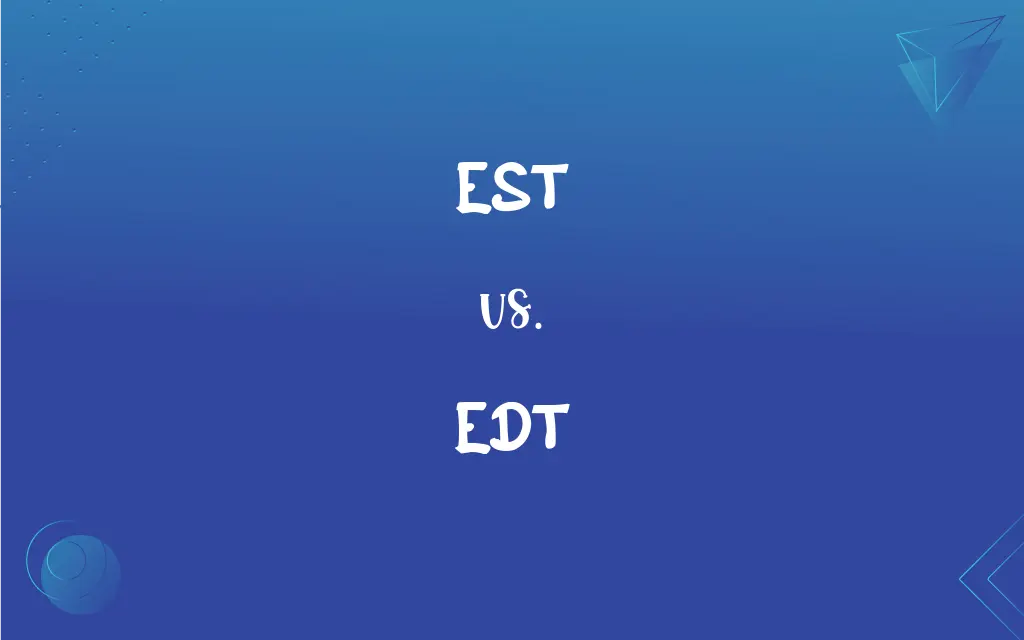EST vs. EDT: What's the Difference?
Edited by Aimie Carlson || By Janet White || Published on November 25, 2023
EST (Eastern Standard Time) is GMT-5, used in winter. EDT (Eastern Daylight Time) is GMT-4, used in summer.

Key Differences
EST (Eastern Standard Time) and EDT (Eastern Daylight Time) represent time zones in parts of North America. EST is UTC-5 hours, whereas EDT is UTC-4 hours. These designations help in identifying the current time standard being used.
The primary difference is their use in relation to daylight saving time. EST is used during the fall and winter months when there is no daylight saving. In contrast, EDT is used in the spring and summer, during daylight saving time.
Both EST and EDT are used in the same geographical regions, such as parts of the United States and Canada. The change between EST and EDT occurs to make better use of daylight during the longer days of the year.
The switch between EST and EDT affects various aspects like business hours, broadcasting schedules, and public transportation timetables. It's crucial for international communication and scheduling.
The transition between EST and EDT is mandated by law in regions that observe it. It also has cultural implications, marking the change of seasons and affecting local customs and activities.
ADVERTISEMENT
Comparison Chart
UTC Offset
UTC-5
UTC-4
Usage Period
Fall and Winter
Spring and Summer
Daylight Saving
No daylight saving
Daylight saving in effect
Impact on Activities
Standard time for regular hours
Adjusted for longer daylight
Cultural Significance
Marks end of summer
Marks start of summer
ADVERTISEMENT
EST and EDT Definitions
EST
EST applies during winter months.
EST begins in November after daylight saving ends.
EDT
EDT represents the time with an hour of daylight saving.
Clocks are set one hour ahead during EDT.
EST
EST is the standard time in its zone without daylight saving.
EST remains constant in regions not observing daylight saving.
EDT
EDT indicates longer daylight hours.
EDT ensures more daylight in the evening.
EST
EST is vital for scheduling in Eastern US.
International meetings are often scheduled according to EST.
EDT
EDT is 4 hours behind UTC.
During EDT, Boston is UTC-4.
EST
EST is used in parts of North America.
Florida switches to EST in November.
EDT
EDT is the daylight saving time in the Eastern Time Zone.
EDT starts in March, moving clocks forward.
EST
EST is a time standard 5 hours behind UTC.
New York operates on EST during the winter.
EDT
EDT is used during summer months.
EDT is observed from March to November.
EST
(obsolete) Grace; favour.
EST
Abbreviation of established
EST
Init of w:Erhard Seminars Training, a course intended to promote satisfaction with life in the present moment, as opposed to strivings to attain it.
EST
East.
EST
Standard time in the 5th time zone west of Greenwich, reckoned at the 75th meridian; used in the eastern United States
FAQs
What is EDT?
EDT is Eastern Daylight Time, UTC-4 hours, used in summer.
When do regions switch from EST to EDT?
The switch occurs in March, marking the start of daylight saving time.
Do all states in the Eastern Time Zone use EDT?
Not all; some areas do not observe daylight saving time.
Is EDT ahead or behind EST?
EDT is one hour ahead of EST.
How does the EDT to EST transition occur?
Clocks are set back by one hour.
When do regions revert from EDT to EST?
This happens in November when daylight saving time ends.
What is EST?
EST is Eastern Standard Time, UTC-5 hours, used in winter.
Why do we use both EST and EDT?
They are used to make better use of daylight during different seasons.
Is EST the same as Eastern Time?
Yes, when daylight saving is not in effect.
How do businesses cope with the EST/EDT change?
By adjusting operating hours and communication schedules.
Does EST affect international communication?
Yes, it's crucial for scheduling across different time zones.
Are EST and EDT used worldwide?
No, they are specific to certain North American regions.
How does EDT impact daily life?
It affects things like business hours and public transportation.
What happens to timekeeping during the EST to EDT switch?
Clocks are set forward by one hour.
Can EDT affect sleep patterns?
Yes, the time change can impact circadian rhythms.
Are there health impacts associated with EST/EDT shifts?
Some studies suggest impacts on sleep and overall health.
Where is EST predominantly used?
In Eastern parts of the USA and Canada.
Do international flights adjust for EST and EDT?
Yes, flight schedules are adjusted accordingly.
Do digital devices automatically adjust for EDT?
Most modern devices adjust automatically.
How important is understanding EST and EDT for travelers?
Crucial for managing itineraries and avoiding confusion.
About Author
Written by
Janet WhiteJanet White has been an esteemed writer and blogger for Difference Wiki. Holding a Master's degree in Science and Medical Journalism from the prestigious Boston University, she has consistently demonstrated her expertise and passion for her field. When she's not immersed in her work, Janet relishes her time exercising, delving into a good book, and cherishing moments with friends and family.
Edited by
Aimie CarlsonAimie Carlson, holding a master's degree in English literature, is a fervent English language enthusiast. She lends her writing talents to Difference Wiki, a prominent website that specializes in comparisons, offering readers insightful analyses that both captivate and inform.


































































